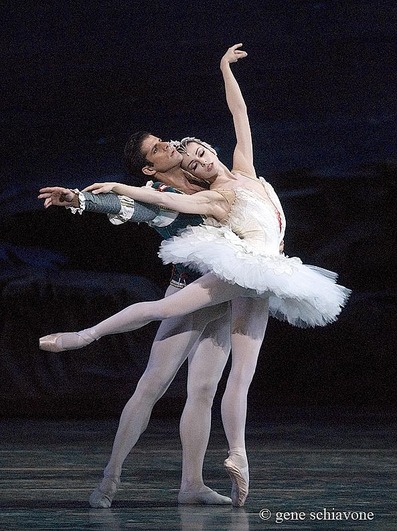Diana Vishneva approaches her roles with a completeness of imagination that makes the usual day-after review–this worked, that didn’t–feel especially meager.
For example, in Swan Lake most ballerinas identify the swan queen Odette’s creaturely gestures with her fear, her guardedness, her vulnerability–the feelings that Prince Siegfried’s everlasting love promises to defuse. But last night at the Met, Vishneva made clear that her swan gestures–extraordinarily expansive and sinuous–would no more disappear than the years of sorrow imprinted on her character. The prince (here a game Marcelo Gomes) has arrived too late. Odette can only receive his love, not reciprocate it, and she can only receive it like a queen–through the shield of her station.
During the long, iconic pas de deux by the lake where Siegfried finds Odette, Vishneva doesn’t look at him, or at least she doesn’t see him. She looks inward and moves through a deep sorrow in one long exhalation of steps ribboned with creaturely impulse. This Odette is not sharing a story; Siegfried is simply overhearing one. She wants someone’s help, someone to pledge his love, the way a pidgeon wants bread crumbs. Siegfried could be anyone.
Vishneva reveals how a woman losing personhood acquires wildness and queenliness in equal measure. Vishneva has taken what we normally think of as opposite ends of a spectrum–on one end, the ritual formality of a queen, on the other, instinct–and bent them into a circle. In her, hopelessness, queenly reserve, and animal otherworldliness merge.
Her interpretation may not make for great theater–it renders Siegfried nearly superfluous–but it yields great poetry and great insight, perhaps more even than Swan Lake can bear.
The American Ballet Theatre summer season continues this week with “Swan Lake,” next week with Frederick Ashton’s “Sylvia” (Vishneva debuts in the title role) and its final week with Kenneth MacMillan’s “Romeo and Juliet” (which the ballerina has performed several times now, always incredibly). Also, ABT has just announced its short fall season, at Avery Fisher Hall this year: all new works, by Aszure Barton, Benjamin Millepied, and Ratmansky. Neat!
[Postscript below this photo:]
Marcelo Gomes and Diana Vishneva in Swan Lake.Photo for ABT by Gene Schiavone.
On a more mundane note, whoever is designing–or executing– the lighting for Swan Lake (not to mention all sorts of other ballets at the Met this season) should be tutored in the basics. Last night, it wasn’t just a matter of lousy conception, though that was a problem, too. (Examples: Overuse of side lighting and underuse of the overheads, so you couldn’t see the dancers’ faces; only one spot for the two leads, so when they weren’t in each other’s arms you could only see one of them at a time; the front of the stage bathed in gloom even when that’s where the action was). It was also a matter of absurdly amateurish execution: the spot dawdling behind its object, half the swan corps sunk in shade so they seemed smaller in number than they were, etc. Afterward, my friend Elaine wanted to know, “Why shouldn’t the prince prefer the black swan? She was much more fun.” But Elaine couldn’t really see the white swan!
Also–I hate this sort of commentary, as it feels like a violation of the dancer’s privacy, but as it bears on aesthetic issues, I’ll risk it–La Vishneva has gotten so skinny, her white swan tutu hanging on her frame, that it’s starting to have artistic consequences. In multiple pique turns, her arms wobble in their roundedness, probably from upper-arm weakness (I’ve noticed this in other very thin dancers, and not in anyone else). And such thinness puts incredible pressure on a dancer’s technique. It’s the Gelsey Kirkland effect, where as long as the dancer has achieved a perfect calculus of balanced limbs, her weightlessness works. But otherwise, she has no extra muscle to get through small deviations from perfection. I could understand how a maniac like Vishneva might like the extra challenge, but in the long haul I’m not sure it’s good for her dancing or herself.
I’ll write again when I can, about some of the dances I’ve seen in the last few weeks (including a revisit to Ratmansky’s On the Dnieper, where it seemed even better).


Leave a Reply